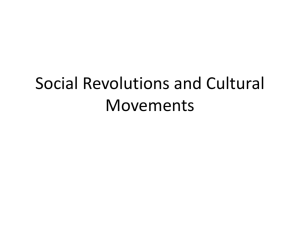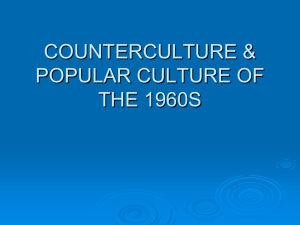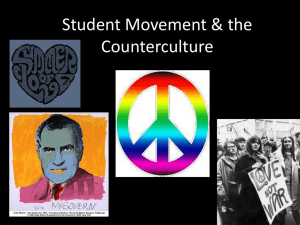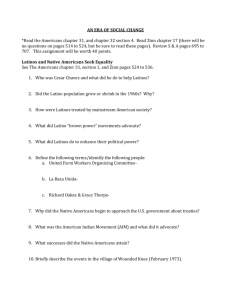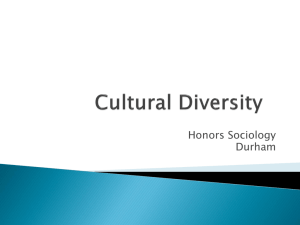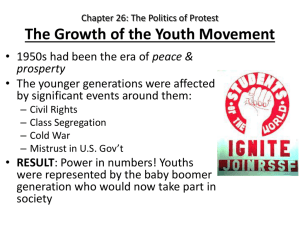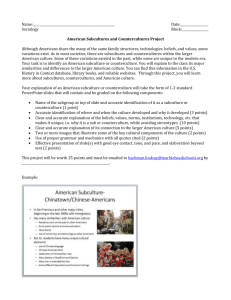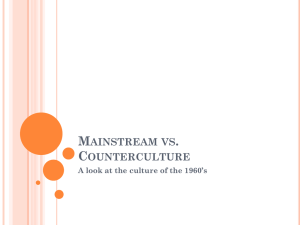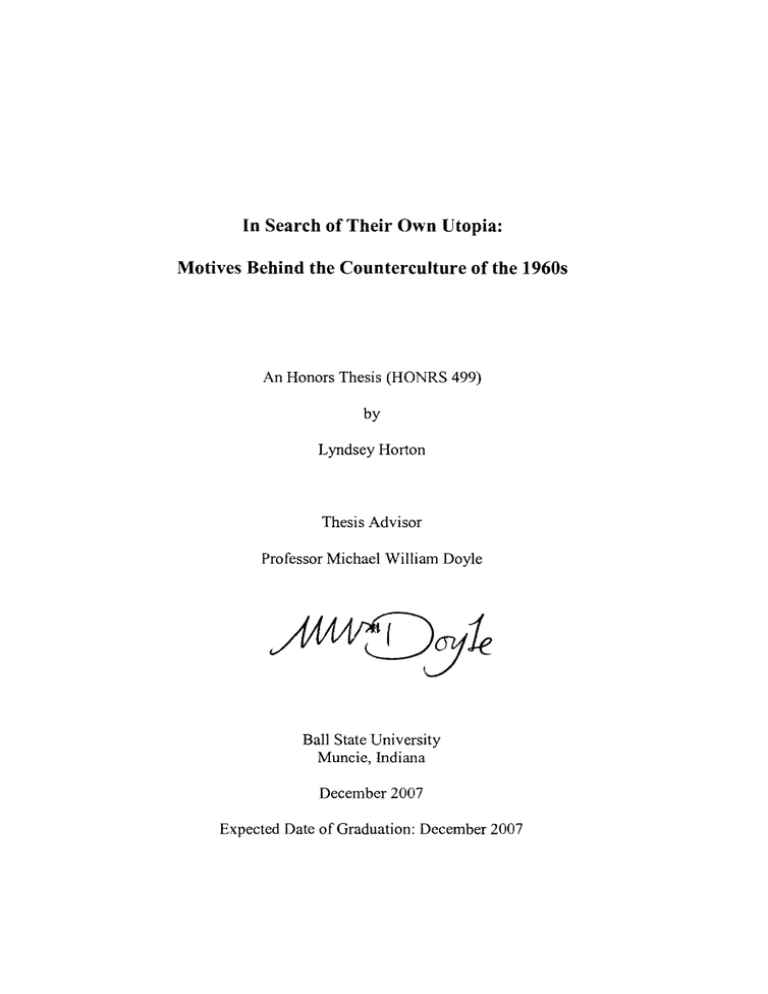
In Search of Their Own Utopia:
Motives Behind the Counterculture of the 1960s
An Honors Thesis (HONRS 499)
by
L yndsey Horton
Thesis Advisor
Professor Michael William Doyle
Ball State University
Muncie, Indiana
December 2007
Expected Date of Graduation: December 2007
7
. TI G 7
Abstract
Even before the 1960s were over, people were studying the counterculture. In the
four decades that have passed since this tumultuous decade, scholars have written
numerous books. In this thesis, I evaluate five of those books including: Make Love, Not
War by David Allyn; Acid Dreams: The Complete Social History: The CIA, the Sixties,
and Beyond by Martin Lee and Bruce Shlain; Tomorrow Never Knows by Nick Bromell;
Imagine Nation: The American Counterculture of the 1960s and '70s edited by Michael
Doyle and Peter Braunstein; and Gates ofEden: American Culture in the 1960s by
Morris Dickstein. In the historiography of the 1960s, I believe these are the five best
books. By evaluating these books I attempt to answer the question of what pushed these
individuals to break away from society and form a counter culture. During the 1960s
many were unhappy with both society and the government. So what was it that made
these individuals break away from the lifestyle they knew and form what was to become
known as the counterculture? Also included are reasons as to why the counterculture
began to fade and opinions on its successes and failures.
Acknow ledgements
-I want to thank Dr. Michael Doyle for his guidance, patience, and support
throughout this project. His knowledge as well as his dedication to helping his
students was invaluable.
-1 would also like to thank Dr. Charles Argo for his instruction of historiography.
The era of the 1960s in American history was, by far, the most tumultuous and
eventful oftimes in our young nation's record. Not only were we at war overseas, we
were at war within our own nation. Unlike times before when faced with a foreign war,
the hated enemy did not wear a specific colored unifOlm and not everyone in the nation
gathered behind the government in support. Within our own borders, the 1960s
witnessed the United States being nearly as tom as it had been one hundred years prior
during our nation's Civil War. Distrust of our government as well as an intense dislike of
our nation's overall lifestyle led many individuals to break away from mainstream culture
and form what would be known as the counterculture.
Such a term brings to mind visions of a young, sexually active, drugexperimenting, stereotypical "hippie." These individuals are regarded with interest and
to some degree, mystique. During their time, however, they were anything but an object
of affection for mainstream America. As Ronald Reagan once said, a hippie is someone
"who dresses like Tarzan, has hair like Jane, and smells like Cheetah." Despite the
attacks members of the counterculture received from mainstream society, they remained
adamant to live their life contrary to their upbringing.
Even in times of prosperity and growth, it is hardly uncommon for a citizen to be
unhappy with his or her form of government. The individuals of the counterculture
dropped out of mainstream society because the prosperity of the nation gave them the
ability to provide for themselves. Lies discovered within the government further pushed
them away from trusting our country's foundation. To improve as a civilization we must
always yearn for a better life. Members of the counterculture needed to break away from
all that they knew to be nonnal in order to experiment with what they could do to make
society the best it could be. However, not all citizens break away and fonn what is to be
known as a 'counterculture.' So what made those of the 1960s different? Why were they
the ones who had had enough and decided to create an alternate lifestyle from
mainstream America? These are all questions which can be pondered and never
definitively answered. It is my purpose to provide a response and attempt to explain such
actions.
In an attempt to answer such questions, one must give some basic criteria and
boundaries in which to work. The term "the '60s" is a broad range of time not
necessarily beginning January 1, 1960 and ending December 31, 1969. For the purpose
of this paper, the '60s will range roughly from 1964 with the first tour of the Beatles in
America and the rise of Beatlemania to the late '70s when America began to feel pressure
from a suffering economic situation. This constricting economic pressure limited those
who had fonnerly spent their time protesting but then had to start using their time in a
manner which would provide a more stable living situation.
In addition to defIDing the time period of the '60s, one must attempt to give
limitations to those who were in "the counterculture." Such a label is nearly impossible
to give someone since in fact becoming a member of the counterculture meant rejecting
labels, memberships, or anything that would provide later scholars with data regarding
who was part of this group. Therefore we must let the label hang loosely and those who
wish to may grab it. For the purpose of this paper, members of the counterculture are
ones who consciously went against social nonns of the time, whether publicly or
2
privately. They may claim to be a member of the counterculture based on their sexual
practices, drug experimentation, or basic belief system. In any case, it is hardly the
purpose or appropriate setting for this paper to attempt to give or deny credit to any
individual as a member of the counterculture. Rather, the purpose is to take a look at
what pushed these individuals to break away from mainstream traditions and create a
counterculture. These are the individuals which make the 1960s fascinating. The era will
continue to be studied and debated long after the last claimed (or unclaimed) member of
the counterculture is gone. It is a task which will most likely end with more questions
than answers; such is the cycle of history which continues to provide scholars with new
inquiries.
In an attempt to answer what it was that pushed the counterculture to reject
America during its most prosperous time up to that point in our history, I selected several
writings by scholars who have spent considerable time studying the 1960s. While the
historiography of the '60s is limited, there are many books available that offer insight to
specific aspects of this era. For that purpose, this paper will examine five different
books: David Allyn's Make Love, Not War; Martin Lee and Bruce Shlain's Acid Dreams;
Nick Bromell's Tomorrow Never Knows; Morris Dickstein's Gates ofEden; and Peter
Braunstein and Michael William Doyle's Imagine Nation. Braunstein and Doyle's work
is the most complete composition of essays on the counterculture; within this book
readers can fmd essays on nearly every aspect of the counterculture. Within the other
four books mentioned, scholars can investigate more specifically on an aspect of the
3
counterculture. To begin, we will look at how David Allyn examines sexuality and its
role in American during the 1960s and beyond.
David Allyn does a superb job in analyzing the sexual revolution in his book
Make Love, Not War. Allyn begins by asking a fundamental question many have
attempted to answer: What was the sexual revolution?l This question sets the basic
framework from which Allyn researches. Other questions which Allyn attempts to
answer throughout his book stem from his original inquiry: Who were the people who
rebelled against sexual mores in the sixties and seventies? What sort of personal risks did
they take? Why did they challenge the authorities? What form of resistance did they
meet? How did they succeed? How did they fail? What was life like before the sexual
revolution and to what extent was it really changed?2
It was because of these primary questions that I chose Allyn's book as a source of
research. David Allyn is a social scientist who studied at Harvard University. He is
currently active in his scholarship at Princeton University. His question of why people
challenged the authorities fell directly in line with my original question framed within my
thesis statement inquiring as to what made those within the counterculture different from
others who find themselves dissatisfied with a government institution.
In answering his questions, Allyn begins the chronology of the sexual revolution
with the 1962 publication of the best-seller Sex and the Single Girl by Helen Gurley
Brown. Within this book. Brown unabashedly admits to having premarital sexual
relations. Brown's book's success stemmed not only from her open admission of her
sexual relations but also in large part comes from her ability to reach both single girls and
4
Madison Avenue executives alike with a blend of consumerism and individualism. 3
From Brown's book Allyn's chronology continues into the beginning of the 1970s, where
he acknowledges 1973 as the year of downturn for the sexual revolution. Sideswiped by
an economic crisis filled with high unemployment rates and even higher oil prices,
Americans no longer had the time or energy to devote to sexualliberation.4
Throughout this decade of time Allyn analyzes his focus falls primarily on eastand west-coast cities. However, along with his anecdotes of San Francisco and
Greenwich Village, Allyn does at times include the rest of the nation in with his
inquisition of the sexual revolution. When discussing the research of sexual science
being conducted during the sixties, Allyn includes a married couple from Peru, Indiana.
The couple told of their own experiences with sex therapists during this time period when
sex therapy was becoming more accepted than in the past. This shows that Allyn
included more thanjust the coastal cities in his research.
Although Allyn acknowledges the downward turn of focus on sexual liberation
that began to occur during the mid-1970s, he makes an excellent point toward the end of
his book. A significant number of Americans continued to support indispensable
elements of the sexual revolution. By 1977, polls showed that seventy-seven percent of
Americans believed public schools should provide sexual education. Over ninety-percent
of Americans surveyed believed birth control information should be freely available.
5
These are issues still being debated today and therefore some may be quick to say that the
sexual revolution was not a success because it did not put these issues to rest. To the
5
contrary, Allyn points out, the sexual revolution was not all good nor all bad, neither all
successful nor all failure.
This ambiguity associated with the sexual revolution coincides with the manner in
which Allyn both begins and ends his book. His book begins with the elemental
question, "What was the sexual revolution?" and ends with more questions: How do we
acknowledge the sexual desires of children and teach them about their choices without
invading their privacy or making them feel pressured to have sex? How do we craft laws
and workplace policies that prevent sexual harassment but do not encourage witch hunts
or further alienate us from our own bodies? How do we protect free speech but maintain
aesthetic standards for our communities, our literature, our art?6 I believe it is a source of
strength in a book when at the end of his or her research, an author does not necessarily
answer the questions in which he sought to answer but rather has transformed his old
questions into new inquiries.
As a final point of strength in Allyn's work I agree with the review written by
historian Ruth M. Alexander. She states that Allyn successfully stays away categorizing
liberationists as either "authentic", "artificial", "opportunists" or "exploitive.,,7 This is
true as Allyn addresses all players in his work in a non-judgmental fashion. He saw that
each played a role in the overall sexual revolution. While he acknowledges that feminist
lesbians and Hugh Hefuer's playmates loathed one another, Alexander points out, he
more importantly recognized that each were interested in enhancing individual
expression. 8 These strengths outweigh flaws pointed out by Jane Gerhard of Harvard
University. In her review in the Journal ofAmerican History, Gerhard states that Allyn
6
offers little new insight into the sexual revolution. Rather, she states that he loosely
strings together events year-by-year. 9 I contrarily believe that Allyn does in fact give us
in-depth insight to the sexual revolution while at the same time acknowledging that he
himself is still searching for answers.
Sexuality was not the only way in which members of the counterculture expressed
individuality. In fact, everything that counterculture members did was done in the name
of embracing individuality. Another important element of the counterculture was drug
experimentation and usage. Mind-blowing experiences with sex or drugs or music were
the most likely ways to alter the worldview of America's youth. 10 Especially widespread
among members of the counterculture were hallucinogens, commonly LSD or acid. For
an in-depth social history of LSD in America one should read Martin Lee and Bruce
Shlain'sAcid Dreams: The Complete Social History: The CIA, the Sixties, and Beyond.
Lee and Shlain take readers through a forty-year span oftime to learn the origins of the
mind-altering drug. LSD-25 was synthesized by Dr. Albert Hoffman in 1938 but the
effects were unknown to him for the first five years. It was not until 1943 that Dr.
Hoffman accidentally discovered the hallucinogenic effects of the drug. 11
Dr. Hoffman's own timeline coincided with the United State's Office of Strategic
Services (OSS) and their quest to discover a truth-serum. In 1942, the OSS assembled
scientists and asked them to begin conducting a top-secret research program to develop a
speech-inducing drug for use in intelligence interrogations. 12 While the CIA's actions
may prove questionable by ethical standards, such proceedings came at a time when the
fear of communism was both consuming and controlling. If the CIA believed that a drug
7
could be concocted that would help bring down communism. ethics quickly took a
backseat in the name of experimentation. In Acid Dreams, Lee and Shlain give detailed
accounts of the development of acid from the time of synthesis and end in 1977. It was
in October 1977 that Dr. Hoffinan gathered for a weekend conference at the University of
California in Santa Cruz. By this point he was revered as a near-mythic figure by a
generation of acid enthusiasts. 13
During this multi-decade study of acid experimentation, the authors focus most of
their attention within the limits of the United States; however the authors must
acknowledge global happenings if for no other reason than the simple fact that Dr.
Hoffinan first synthesized LSD·25 in Switzerland. Important locations within the United
States included both east- and west-coast cities. In the Haight-Ashbury district (which
the authors referred to as the psychedelic city-state) of San Francisco acid was
commonplace. 14 The entire bohemian district was established around the idea of a free
entity in which everything (including drugs) was handed out free of charge.
Far away from California was Millbrook, New York. After Leary and his
colleague Richard Alpert were expelled from Harvard in connection with their
psychedelic experiments, they were determined to carry out additional studies. It led
them to travel internationally during which time they met WiUiam Mellon Hitchcock. An
immensely rich, young stockbroker, Hitchcock proved to be a vital part of the acid
experiments. He offered his family's four-thousand-acre estate in Dutchess County, New
York which housed a mansion known as Millbrook. Leary, Alpert and his clan now had
living quarters in which to live out their experiments. IS
8
During his reign as acid-king, Leary interacted with numerous individuals who
later were able to give accounts which helped document the roller-coaster ride that was
acid experimentation. Authors Martin Lee and Bruce Shlain are both journalists who
interviewed numerous people during the research for this book. 16 Lee received his
undergraduate degree in philosophy from the University of Michigan. In 1994, he
received the Pope Foundation Award for Investigative Journalism. Shlain is a sports
writer who has previously published two books on the subject of baseball. In writing
their book, the authors relied not only on other books but heavily on primary documents.
Nearly 20,000 pages of once-classified government documents were released by the
Freedom of Information Act. This provided the authors with invaluable information
about the CIA and their involvement with psychedelic drugS. 17
While giving them credit for their investigative skills in providing new
information about the CIA's involvement with hallucinogenic drugs, Richard H.
Immerman of the University of Hawaii takes aim at what he believes to be Lee and
Shlain's lack of analysis and critique. Immerman believes that the authors could not
decide whether to focus on the role of drugs in the political spectrum or the popular
culture and thus provides a book which offers little insight into either world. 18 I do not
believe that to be true. While the book is distinctly divided into the CIA's role and the
public's role in drugs, I believe that Lee and Shlain used both to enhance, not detract,
from one another.
While sex and drugs played a prominent role in counterculture lifestyle, it is
impossible to forget the role of music. For members of the counterculture music was less
9
about entertainment and more about a way oflife. Nick Bromell's Tomorrow Never
Knows shows an excellent portrayal of the relationship between rock and psychedelics in
the 1960s. In reading Bromell, one is able begin to grasp the intensity in which the
counterculture lived through the music: "[ ... ] simplicity ... that can be recaptured only by
listening to Beatles songs again, is what explains their appeal and their meaning. Their
simplicity said, in effect, that innocence has virtue and validity.,,19
Bromell also uses analysis given by others since 1960 to place his appreciation for
rock in context. He quotes Allen Ginsberg as saying that the Beatles opened a new door
in America; this door combined complete masculinity and complete tenderness and
vulnerability. For those who accepted this combination, the result was more openminded, open-hearted relationships within their lives. 2o
The importance of the Beatles is impossible to miss when reading Bromell. His
opening chapter describes the beginning of the Beatles as a feeling of an ending. While
the start of the Beatles was something amazing and life-changing, it is true that they say
the beginning of one thing means the end of another. The beginning of the Beatles
signaled to some the end of the life as they knew it. 21
While drawing on the input of key figures from the era, Bromell is most
successful in making readers feel as if the music is a quasi-religious experience because
of his first-hand anecdotes. He remembers sitting in a dorm room in college smoking
dope and listening to the Beatles and the Stones with others he barely knew. 22 And it
didn't matter how well or ifhe knew the people with whom he was smoking-the music
did the bonding for them.
10
While smoking pot and listening to music was a bonding experience for millions
of young people during the 1960s, it was also an experience shared by musicians which
changed their music. Bob Dylan first introduced the Beatles to marijuana, which began a
drug usage that would lead to acid. After this experience, the Beatles joined Dylan in
making music in a more personal manner. Their music began to be inundated with
personal feelings and awareness. Suddenly, the music wasn't just about the music; it was
now also about the relationship between rock performers and rock artists. 23
Therefore, when reviewer Edward Macan of College of the Redwoods states that
Bromell does not offer a close analysis of the sounds of rock itself, he is absolutely right.
Nor does Bromell offer readers a comprehensive writing of sixties rock?4 Macan
acknowledges that Bromell was interested instead in the ideas portrayed through the
music. The reviewer states the weakness that Bromell himself is not a musicologist and
thus relied on the authority of others. This is indeed true as Bromell is currently director
of graduate studies in the English department at University of Massachusetts Amherst.
But while as a reviewer Macan may find this to be a weakness, I do not agree. If
one is looking for an in-depth analysis of the music itself from the 1960s then Bromell' s
book is not appropriate. However, for scholars of the '60s, I believe Bromell's book is
absolutely appropriate because it shows music in the light in which it was shown in the
1960s: as a way of life. Most of those sitting in dorm rooms across America were not
analyzing the chords and notes throughout the songs. Rather, they were relating the
music to their own life and the world around them. In his book, that is exactly what
Bromell has displayed.
11
While Bromell's book focused on music, Lee and Shlain's on acid, and Allyn's
on sexuality, Morris Dickstein's book Gates ofEden is the first to be analyzed in this
paper that focuses more broadly on the 1960s. His analysis includes discussions on
writings, music, and American thought. Thus it can be accurately said that this book
deals more with culture in a somewhat wider spotlight. By no means is this to say that
Dickstein lacks substance.
As proof of Dickstein's notable writings on the 1960s, Gates ofEden was
republished in 1997, twenty years after its original publishing date. In his new
introduction "The View from the End of the Century" Dickstein makes a point which I
believe is essential to understanding the counterculture:
'~[ ... ]
the core of the sixties was
not the shifting fashions, or glib antinomian slogans by gurus anointed by the media, or
any strictly political worldview, but the changes in consciousness that lay behind the
public spectacle of the time.,,25
Dickstein begins with the Beat authors to show this change in consciousness. In
his prologue, he stresses the influence of Allen Ginsberg. Ginsberg helped articulate the
changing tide of America by stressing this utopian, romantic, and religious strain that was
ultimately at the heart of the new responsiveness of the sixties.26 In his younger days at
Columbia, Dickstein met Ginsberg and in much the same way that music became
personal to its listeners, Dickstein's meeting with Ginsberg transformed poetry into a
personal experience for him.27
Dickstein continues to recognize the personalization of the arts as he
acknowledges that the young people of the sixties were lookingfor something in
12
literature and not just looking at it. This took a sophisticated amount of tolerance and
eagerness, and these young people possessed that. 28 Dickstein seems to take this
acknowledgement seriously as most of his book, while diversified in culture, is deeply
seeded in American writings as well as culture. Reviewer Jerome L. Rodnitzky from
University of Texas, Arlington comments on this aspect as well. While he credits
Dickstein's writings as eloquent, an appropriate recognition, he then states that the
subtitle for this book should have been "American Writers and American Culture in the
Sixties.,,29 I believe that to be true. While Dickstein does effectively incorporate other
aspects into his book, they are integrated within the realm of literature and authors.
If it appears that Dickstein leans toward writers as a starting block for his writing,
it certainly does not mean that he is uncritical of any of them. As Rodnitzky states,
Dickstein is critical of everyone--youth, writers, professors, even himself-and gives
readers an unsentimental look at the 1960s. It was his hope during the '60s era that the
Gates of Eden were on the verge of opening. However, to his disappointment, they were
not. One such reason has to do with the obvious lack of clarity Columbia students
possessed in defining their goals and demands. As the students attacked the university as
a symbol of the society with which they disagreed, Dickstein felt that they were attacking
one of the few institutions that was sympathetic to their needs. 30 Therefore, Dickstein
saw a door of opportunity shut by those who could not distinguish friend from foe.
Dickstein was of the age to be directly involved in the goings-on during the '60s.
He enrolled in Columbia University in 1957, did graduate work at Yale, and taught at
Columbia during the SDS upsurge in 1968. Because of his intense personal connection
13
with the era, I agree with Rodnitzky that a brief autobiography provided by Dickstein in
an introduction would have been beneficial. For readers to really understand the
assertions an author reaches, especially critical assertions, it is valuable to know their
experiences which may have led to these contentions. 3l
To continue with the assertion that Dickstein's book was heavily influenced by
his own experiences, he is criticized in Reviews ofAmerican History by Professor
Richard King ofthe department of history at the University of District of Columbia.
Geographically, Dickstein focuses on the east-coast, in particular New York. Taking into
account his personal experiences, this is understandable considering his time spent at
Columbia It is unbalanced, however, to not include the important west-coast cities (i.e.
San Francisco) which saw some of the most dramatic happenings of the 1960s.32
It is fair to say then that Dickstein's book Gates ofEden is both brilliant in some
manners and lacking in others. Of the five books analyzed in this paper I felt that Gates
ofEden was the hardest to grasp. In a less-than academic criticism, I would say that
Gates ofEden lacks the ability to reach to those who are not scholars but rather interested
persons wanting to learn more about '60s culture. While the four other books are more
accessible, Gates ofEden is a bit harder with which to work. Again that is not to say that
Dickstein should not receive due credit for his writings; rather it is just another
observation to keep in mind when critiquing the undersized historiography of the
counterculture.
Because of this limited library of books specifically on the counterculture, it was
imperative to include Imagine Nation: The American Counterculture ofthe 1960s and
14
70s. Edited by Michael William Doyle and Peter Braunstein. this book is a collection of
thirteen essays written by scholars regarding various aspects of the counterculture. These
essays are broken up into five sections including deconditioning; cultural politics;
identity; pop culture and mass media; and alternative visions. One of the most important
sections of the book, however, is its introduction.
It is in this introduction that Doyle and Braunstein make an imperative point
which must be kept in mind during any examination of material regarding the
counterculture. They state that the counterculture" ... should never properly be construed
as a social movement. It was an inherently unstable collection of attitude, tendencies,
postures, gestures, "lifestyles," ideals, visions, hedonistic pleasures, moralisms,
negations, and affirmations." It is by this statement that one can begin to understand the
counterculture not by what they were but more so by what they were not. 33
Keeping in mind that the counterculture was not a social movement, the editors
did provide the Sixties counterculture into two phases for the sake of historical context.
The first phase begins roughly around 1964 with the Beatles first tour and fades out after
the election of President Richard Nixon in 1968. This group was the utopian "flower
child" version ofa hippie.34 The second phase came in the early 1970s and was marked
by a fragmentation of the counterculture into various liberation movements. These
movements sought to fulfill radical values outside of society. 35
Given these basic parameters it is easy to see that the chronology follows from
roughly 1964 through the mid- to late-70s. Geographically the two meccas of the
counterculture are listed as San Francisco's Haight-Ashbury district and New York's East
15
Village. 36 What gives this book balance, however, are the essays within that include
other cities such as Detroit and Ann Arbor, Michigan.
In these two Midwestern cities the White Panther Party became a target for the
FBI's COlNTELPRO during the late 1960s and very early 1970s. Jeff A. Hale's essay
titled "The White Panthers' 'Total Assault on the Culture,]7 focuses on the
countercultural impact upon the Midwest, which especially in Ann Arbor, Michigan, also
saw happenings similar although less extreme than coastal cities.
The essay focusing on the White Panthers Party is only one of many fascinating
writings contained within this compilation. Beth Bailey contributed an essay regarding
sexuality and underground comics. Everything from feminism (Debra Michals' "From
'Consciousness Expansion' to 'Consciousness Raising': Feminism and the
Countercultural Politics of the Self) to guerilla theater (Michael William Doyle's
"Staging the Revolution: Guerilla Theater as a Countercultural Practice, 1965-1968) to
music (Lauren Onkey's "Voodoo Child: Jimi Hendrix and the Politics of Race in the
Sixties) is included in this expansive writing on the counterculture.
With a book which includes writings by so many different scholars, praise should
be given to editors Peter Braunstein and Michael Doyle. To gather texts and make them
flow smoothly under the ever-reaching umbrella of "the counterculture" is not an easy
task. Peter Braunstein is a journalist and cultural historian based in New York City. He
received his M.A. from New York University having written a thesis on the HaightAshbury counterculture.38 With similar interest within the counterculture, Michael
William Doyle earned a B.A. from the University of Wisconsin-Madison and a Ph.D. at
16
Cornell University after writing his dissertation regarding The Haight-Ashbury Diggers.
Professor Doyle currently is assistant history professor at Ball State University in
Muncie, Indiana.
In the introduction to Imagine Nation editors Braunstein and Doyle make the
point that the easy tenn "counterculture" easily leads to a lost definition of what the tenn
actually represents. It quickly loses its historical standing. 39 Therefore it is difficult for
any student of the counterculture to give boundaries to what exactly it is they are
studying. While at times it is a maddening process, it is this inability to nail directly to
the wall the concept of study which makes the subject endlessly fascinating.
This fascination is drawn to the general direction of those in the era of the 1960s
in America who were exhausted with their way of life and decided to go against societal
nonns and create their own culture, thus a "counterculture". What made these
individuals different from others who have become dissatisfied with their government?
The answer is neither easy nor concrete.
For the young people of the 1960s the world was very different than it had been
for their parents. The generation before them had watched the nation prosper whereas the
'60s children were born into a nation with unprecedented wealth. As Dickstein states in
his book, "Whatever spiritual yearnings were satisfied, sex and drugs were also
extensions of the consumption ethic of the postwar years.,,40 Therefore they could afford
to leave the prosperity that they once knew and enter a different world of aftluence. And
while this new world may not have been focused on material goods and services, it
17
certainly held its own structure of wealth and consumption which allowed those entering
it to feel secure.
These young adults also knew that their parents would continue to live in this
materialistic and prosperous world. And while they would be hard-pressed to admit it, it
must have been some reassurance (perhaps even subconsciously) that they could return to
their former safe-haven when needed. This can also begin to explain the decline of the
counterculture when the economy hit a lull in the mid-l 970s. Without the surplus in the
economy, those who took it for granted that they could drop out of society yet re-enter at
any time realized that this easy track back to a stable life may not always be there.
Besides the economic factors changes in our nation's trust in our government had
a sure effect on those citizens who became members of the counterculture. At one point
United States citizens would not have questioned the authority of their president. But
when the Vietnam War dragged on without hope in sight, and most defInitely after the
Nixon Watergate scandal, some who had placed their trust in the higher government
system took back that trust. Therefore, it seemed to be common sense to reject a system
which so blatantly lied to its people.
While war waged in south-east Asia and throughout America, citizens began to
yearn for a different setting. Dickstein wrote, "Utopia always eludes our grasp, but we
still need it as a regulative idea ... unless we dream of a perfect society, we're unlikely to
achieve a better one:.41 As scholars and historians we will continue to ask the question
of what pushed these individuals to leave behind the comfort of their homes and enter a
world unbeknownst to them. We will ponder how it was exactly that they defIned
18
themselves. and whether they acknowledge what they did to be a success or failure. As
brilliantly stated by Braunstein and Doyle, "Countercultural knowledge can't be
accurately represented by a straight line, or even the squiggly line; a more evocative
figure would be the matrix, or perhaps the concentric circle.'.42 We will continue to study
and question. At the same time, we will continue to appreciate and respect the place in
history which belong those who were considered members of the counterculture.
David Allyn. Make Love, Not War. (Boston: Little, Brown and Company. 2000).3.
Allyn, 3.
3 Allyn, 17-18.
4 Allyn, 273
5 Allyn, 289.
6 Allyn, 299.
7 Ruth M. Alexander. "Review" American Historical Review. Vol. 106, No.4, (2001)
hnp:i/www.jstor.org.proxy.bsu.edu/view/00028762/di021267/02JlQI31 nil ?frame=nofTame&userID=93e20
709«Vbsu.edu/0 I cOa84866005087be7~dpi=3&~onfig=j~tor .
8 Alexander.
9 Jane Gerhard. "Review" Journal ofAmerican History. Vol. 88. No 1. (2001)
!mp://www.jstor.org.proxy.bsu.edu/view/00218723/di020 I 60/02p054 Ig/0?frame=noframe&userlD=93e20
709@bsu.edu/0 Ic054500ro050 185cf&dpi=3&<,:onfigc=jstor
10 Peter Braunstein and Michael William Doyle., eds. Imagine Nation. (New York: Routledge, 2002) 306.
II Martin A. Lee and Bruce Shlain. Acid Dreams. (New York: Grove Press, 1985), Xvii-xviii.
12 Lee and Shlain. 3.
13.Lee and Shlain. Xix.
14 Lee and Shlain, 168.
15 Lee and Shlain. 97.
16 Lee and Shlain, 298-322.
17 Lee and Shlain, 323.
18 Richard H. Immerm~ "Book Reviews" Journal ofAmerican History. Vol. 73, No.4. (1987)
http://www. ;5tor. org.proxy .bsu.edu/view/002 I 8723/di952427 /95p0597j II ?fTame=nofTame&u5erID=93e2()1
09@b?u.edu/Ol cOa84866005087be8&dpi=3&config= istor
19 Nick Bromell. Tomorrow Never Knows. (Chicago: University of Chicago Press, 2000), 20.
20 Bromell. 26.
21 Bromell, 17.
22 Bromell. 14.
23 Bromell. 67.
1
2
19
~4 Edward Macan. "Book Reviews" Notes. Vol. 58. No 1. (2001).
http://www . istor.org.proxy.bsu.edu/browse/002 743 SO/ap039I 93/03a003 I 0/0?searchUrl=http%3a1!wwwjg
or.orgisearch/BasicResults%3 fup%3g25%26si%3d J %26gw%3ditx%26jtxsi%3d I%26jcpsi%3d 1%26artsi
%3dl%26Query%3dnick%2bbromell%26wc%3don&frame=noframe&currentResult=002743S0%2bap03Q
I 93%2b03a003 I 0%2bO%2cOF& user ID=93e20709@bsu.edu/0 IcOaSOa 7400503cb2S&backcontext=page&
backurl=/cg!:
bin/jstor!viewitemlO02743S0/ap030 I 93!03a003 I 0/0%3 fsearch U rl%3dhttp%253a1/www.jstor.9rglsearch/Ba
sicResults%253fup%253d25%2526si%253d I %2.526gw%253djtx%2526jtxsi%253d I %2526jcpsi%253d 1%
252fu!rtsi%253d 1%2526Query%25 3dnick%252bbromell%2526wc%253don%26frame%3dnoframe.ro2~<illi
~'03<!J%2Jil!SeL!Q%~d93e20709@bsu.e<lu/Ol cOaSOa7400503cIJ2S%26currentResult%.ldOQ2743S0%252~J2
030 193%252b03a0031 0%252bO%252cOF%26config%3djstor%26PAGE%3dO&config=jstor
~~ Mo~;-Di~kstein. Gates a/Eden. (Cambridge: Harvard University Press 1977), Xiii.
Dickstein. Xiv.
2; Dickstein. 4.
2& Dickstein. 13.
2!t Jerome Rodnitzky. "Review of Books" American Historical Review Vol. 82. No.5. (1977),
16
http://www.jstor.org.proxy.bsu.edu/view/0002S762/di951403/95p0236f70?frame=noframe&userID=93e20
709@bsu.edu/OI c054500d7c30 I I 559 I 2bege&dpi=3&config=jstor
Dickstein. 268.
Rodnitzkv.
~2 Richard King. "A Conflict of Decades." Reviews in American History. Vol. 6 No. 1 (1978).
30
31
!1ttp:llw~w. jstor.or&J2Loxy .bsu.eduiview/00487511/dm980021/98p0022a13 ?search Url=http%3aljww~i~1Q!
.org/search/ilasicResults%3fup%3d25%26si%2<11 %26gw%3ditx%26jtxsi%3d I %26jcpsi%3d 1.!)!Q26aItsi%J
d I %26Query%3dgates%2bof%2beden%2bmorris%2bdickstein%26:wc%3don& fra.m.e=!!9ftame&current R~
sult=004875 I I 0/02bdm98Q021 %2b9Sp0022a%2bO%2c3F&userID=93e20709@bsu.edu/O I cOa80a7400503c
c58&dpi=3&config=jstor
B Peter Braunstein and Michael William Doyle, eds. Imagine Nation. (New York: Routledge, 2002), 10.
34
35
Braunstein and Doyle. II.
Jon Wiener. "Book Review" The Journal ofAmerican History. Vol. 89. No.4 (2003).
http://www.historycooperative.org.proxy.bsu.edu/joumals/jah/89.4/brI42.html
Braunstein and Doyle, 12.
Braunstein and Dovle. 125.
;3 Braunstein and Do~le: 379.
39 Braunstein and Doyle, 6.
4" Dickstein. Xvii.
41 Dickstein. Xix.
42 Braunstein and Doyle, 13.
36
?i
20

